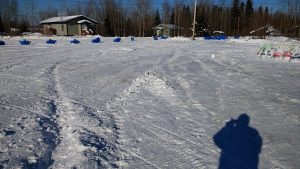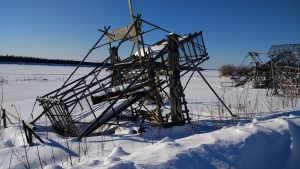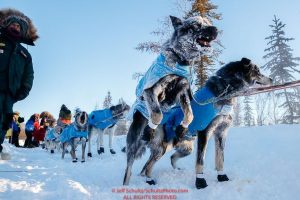Pete Kaiser leads pack
Joe Runyan
Our forward group of Insiders, Greg Heister and I flew from Nenana to Manley, picked up Bruce Lee and with pilot Greg Fischer flew the Tanana River trail to Tanana.
With clear skies, settled weather, and no perceptible wind, Bruce and I saw Aliy Zairkle camped along the trail in a protected slough about 10 to 15 miles out. Temperatures were rising since the very uncomfortable minus 40 F freeze of early morning in Manley. We passed teams alternately traveling and resting beside the trail, finally discovering Pete Kaiser travelling alone at the head of the pack.
A knot of mushers closely traveling behind make any judgement call about any musher taking control of the race MUTE. A dozen—or twenty—mushers are in the hunt. But Kaiser and Buser deserved a place in print as they are now at the front.
I was particularly interested in the trail on the Tanana River. AS pointed out in previous article, locals would be hesitant to put a trail on the Tanana River because its devious history of shifting waters which erase sand bars and undermine trails, often collapsing in open water. The Iron Dog snowmachine race travels up the Tanana, however, so there is accumulated history on the details of installing the trail.
Our trail breakers, the sled heads who fear no snow, did a masterful job on the 77 mile trail, crossing the river at key bends, diverting the trail on shortcut sloughs, and avoiding the occassional open water. ABout twenty miles from Tanana the trail breakers place the trail on the east side of the river and avoided the notorious sand bars of Sqaw Crossing. Apocryphal explanations suggest the Squaw crossing got its name because one could walk across the river on the braided expanse of sand bars. From the air Squaw crossing is unmistakeable , braided with numerous channels across a landscape of sand bars, with the river diffused into a wide bar a couple of miles wide.
Finally, the trail intersects the Yukon on the upriver side of the Yukon-Tanana River confluence and crosses to the Yukon’s north bank and the village of Tanana. Tanana is a busy village of about 225 people and for its size maintains an incredible population of sled dogs. And, in fact, Tanana is well known for the quality of fast traveling sled dogs and a long history of famous mushers. If you want to go shopping for some well bred huskies, Tanana is a good bet. Therefore, the village population knows the sport of dug mushing.

expansive yard near the tanana community center
The village also advertises some serious hospitality. An old friend from my days in TAnana, Tom Hyslop was busy replacing light bulbs, improvising power connection for cameras and equipement and supervising the dog yard operation. IN the past, many mushers rested in Tanana and some declared a 24 hour mandatory break.

Tanana hosts a third Iditarod
The sign on the community center reads “Tanana Welcomes Iditarod Mushers/ We knew you would be back/ 2003-2015-2017.”
The tradition of mushing freight and transportation on the trapline was facilitated by the abundant salmon runs on the Yukon—a dependable source of easy protein. I took a photo of a fishwheel in Tanana, the key to the harvest of big numbers of salmon. Rotating on an axle, the baskets of the wheel dip in ten to fifteen feet of water and intercept salmon swimming up river. These “Wheels” and the big log rafts that support them are pushed out into the current and stuck in position with steel cables. The wheels you see in the photo were taken out in the fall time. In spring, high water and a little push with lever poles launches the wheels. With a boat and an outboard kicker the user can position the wheel in a path of the migrating salmon. Considerable skill and experience is required to place the wheel in just the spot where salmon concentrate—-at a point—-just to the margin of fast current—–or a strong channel that funnels fish, for example.
Once caught, the fishermen in Tanana and other villages along the Yukon will split the fish and score the filets in a way so that winds will dry the fish. Once dried, the fish can be stored for the winter as a reliable and oily dog ration.

Fish wheels, depending on size, can dip fifteen or sixteen feet deep, and intercept migrating salmon
An eight to ten pound salmon, once dried, can feed a hard working trapline husky for two days.
What to look for?
Front pack jockeys for position to Tanana. The defending champ, Dallas Seavey, reports that he is only interested in team maintenance at this stage of the race. To do it, he is a contratrian that rests his dogs by loading them in specially designed kennels while the he and team are on the move.
Check out the photo by Jeff SChultz, photographer extraordinaire on the Iditarod Trail. Jeff is working on a book, Icons of the Iditarod.

Frosted up after a run in sub-zero temps Ray Redington Jr. dogs are still ready to run after Ray checks in at the checkpoint in Manley Hot Springs during the 2017 Iditarod on Tuesday March 7, 2017.Photo by Jeff Schultz/SchultzPhoto.com (C) 2017 ALL RIGHTS RESVERVED

































